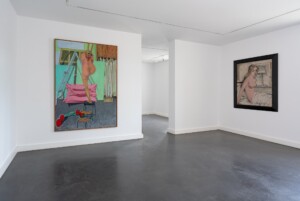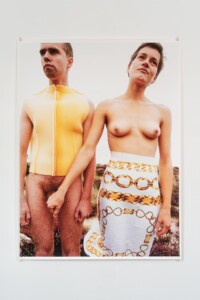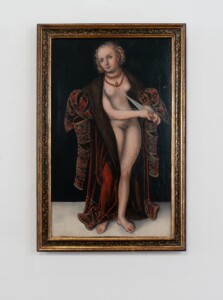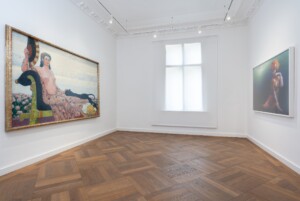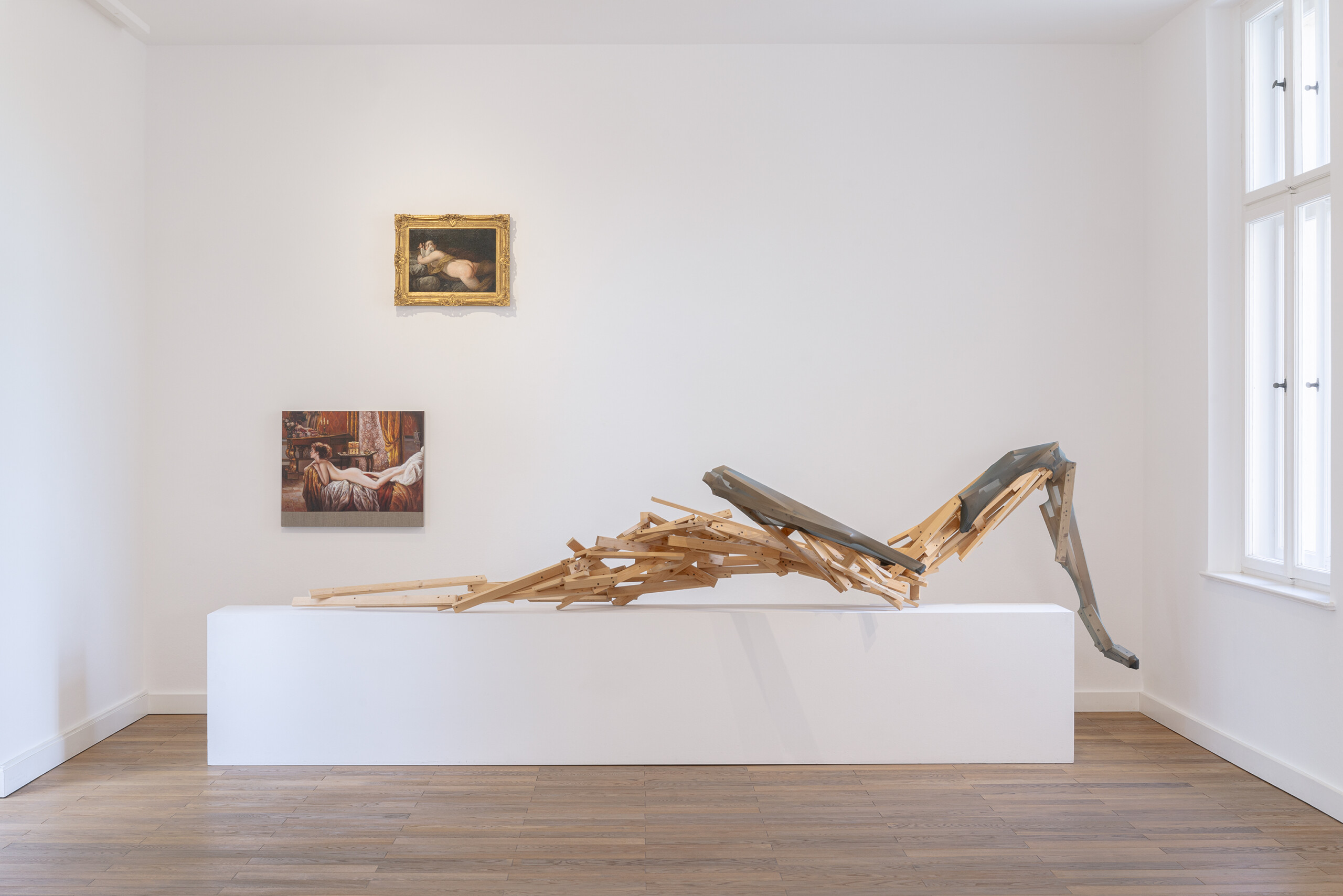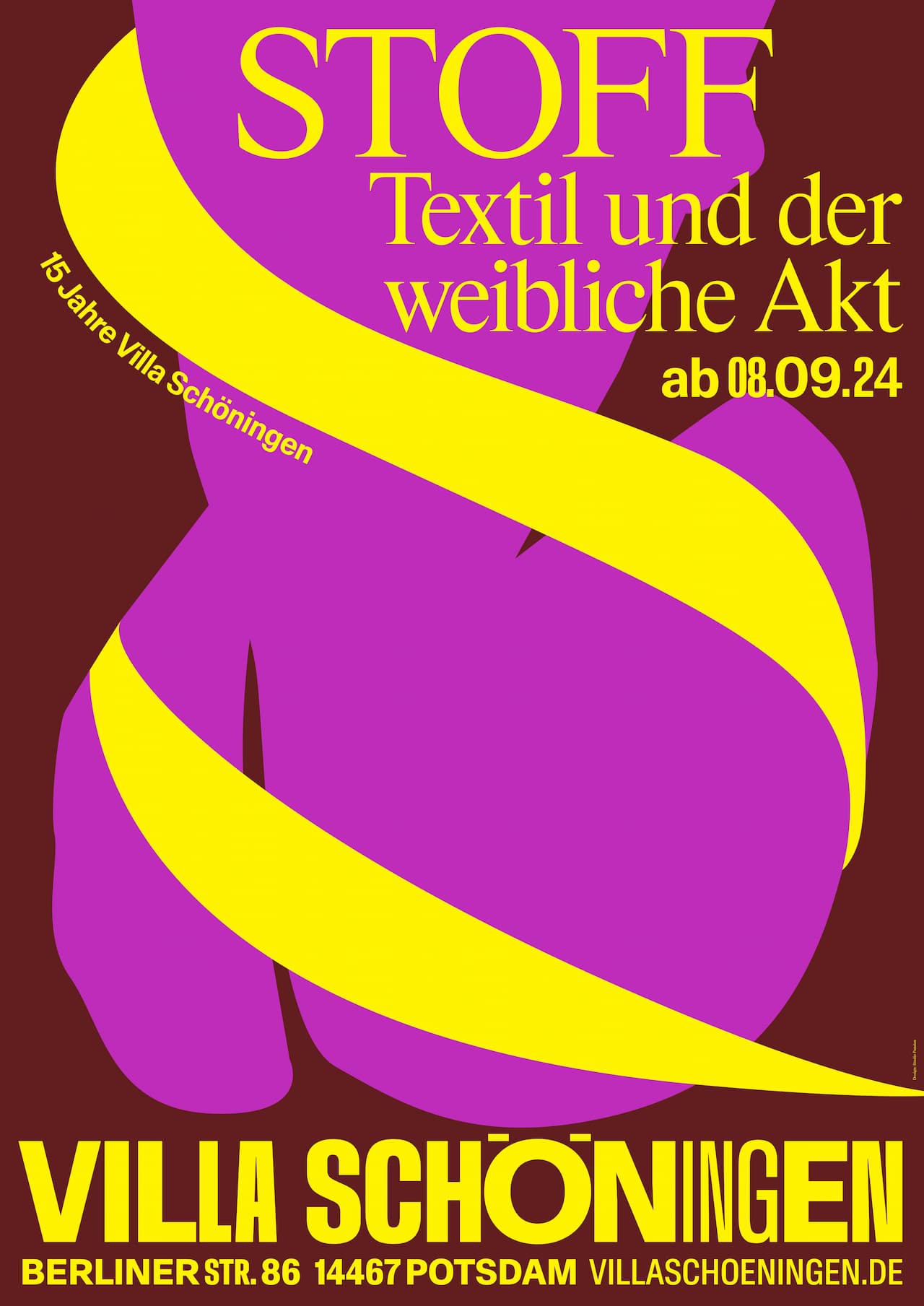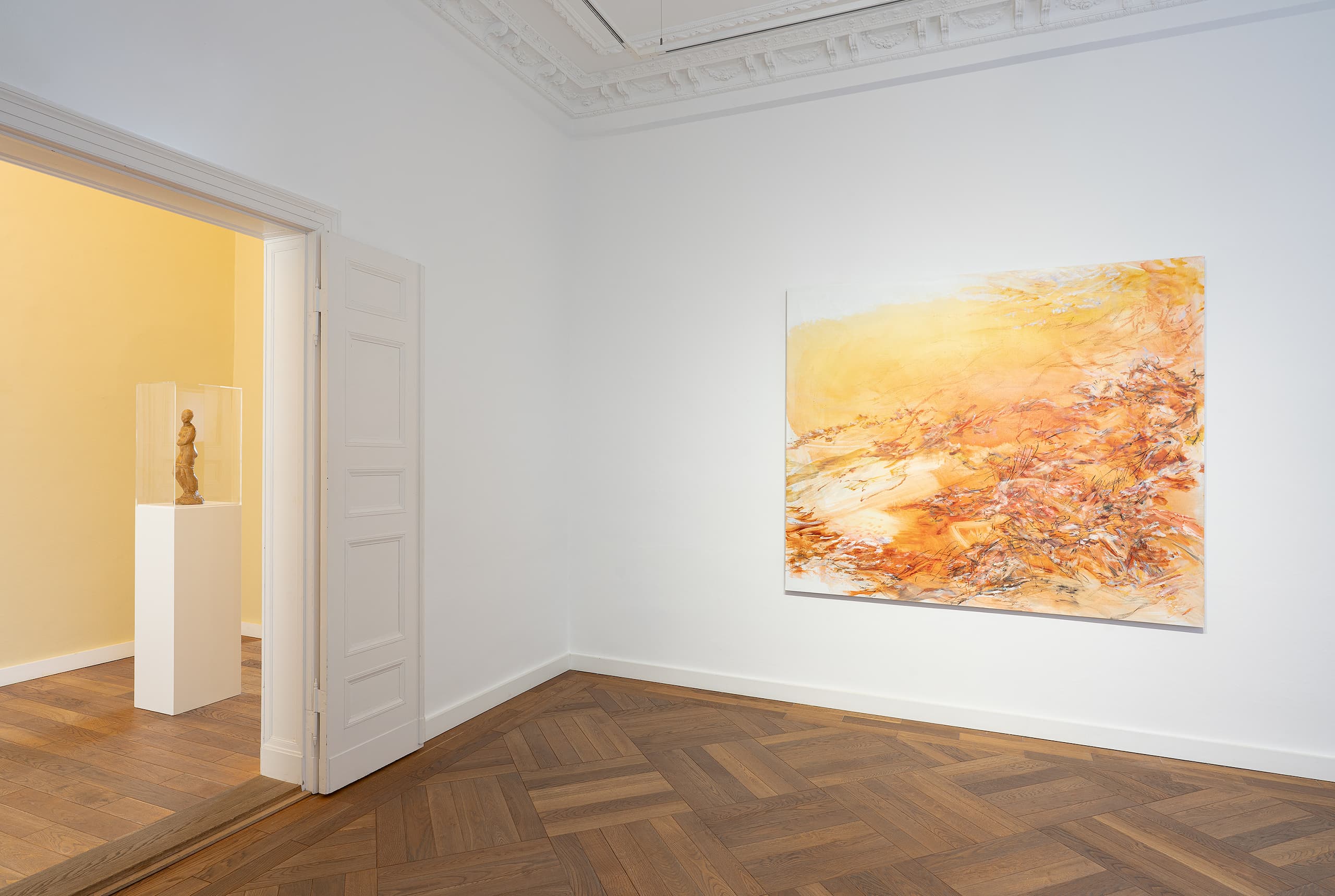Fabric. Textile and the Female Nude
The exhibition Fabric: Textile and the Female Nude explores the connection between textiles and the female nude in art. Featuring around 43 works, ranging from early 17th-century masterpieces to contemporary pieces, the presentation at Villa Schöningen illuminates this and related themes across various artistic genres.
Artists have long considered the depiction of textiles to be the highest achievement in art, a notion that dates back to antiquity. A famous example is the story of Parrhasius’s Curtain, circa 400 BC: In it, the painters Zeuxis and Parrhasius vie for the title of greatest artist. Zeuxis is so fooled by Parrhasius’s trompe l’oeil curtain that he tries to pull it aside, only to discover that it is painted rather than real.
Curtains and other textiles—such as scarves, stockings, or sheets—play a central, theatrical role in art. They conceal and reveal, enhancing the allure of what remains hidden and making it seem all the more desirable. Textiles are a crucial stylistic device in the long tradition of depicting the female nude. But there is an ambivalence there as well: what is rarely seen is frequently objectified and, in the case of the female body, often sexualized.
The dynamic is clearly at work in Hans Rottenhammer the Elder’s Venus Before Her Bath (1610/1620). A delicate shawl extends from Venus’s hand across her body to her intimate area. And yet instead of providing privacy, the partial covering voyeuristically draws attention to the figure’s private parts.
Female contemporary artists engage with and critically examine this tradition. Cindy Sherman, for instance, deliberately portrays herself as an object in her photograph Untitled 447, where she appears in a full-body cloth costume as a naked clown. The ambivalent figure reflects society’s treatment of the female body: a common subject of imagery, yet often censored and objectified.
Interestingly, even the latest technologies such as AI image generators perpetuate problematic views of the female form. While AI typically renders male bodies realistically, images of females are often riddled with anatomical inaccuracies. The phenomenon raises questions about the data sources on which AI is trained and societal perspectives on female bodies in general.
Fabric: Textile and the Female Nude invites viewers to think critically about the role of textiles in portrayals of the female body. The multifaceted function of fabric—as protection, adornment, or deception—not only guide the gaze but also make power dynamics visible and open to challenge.
Perhaps some of the curtain will be lifted to allow for a more open approach to female physicality.
 Norbert Tadeusz, “Karin Kraftmal” , 27.11.1985, Öl auf Leinwand/ Oil on canvas Paul Delvaux, Nu au lever (Le Lever), November 1932, Öl auf Leinwand/ Oil on canvas © Villa Schöningen, Foto: Sascha Herrmann, 2024.
Norbert Tadeusz, “Karin Kraftmal” , 27.11.1985, Öl auf Leinwand/ Oil on canvas Paul Delvaux, Nu au lever (Le Lever), November 1932, Öl auf Leinwand/ Oil on canvas © Villa Schöningen, Foto: Sascha Herrmann, 2024.
 Tamara de Lempicka, Nu assis de profil, Um 1923/ Around 1923, Öl auf Leinwand/ Oil on canvas Wolfgang Tillmans, “ Lutz & Alex holding cock”, 1992, Inkjet Druck/ Inkjet print courtesy the artist and Galerie Buchholz Hans Rottenhammer d.Ä., Venus vor dem Bade, 1610/20, Öl auf Schiefer/ Oil on slate
© Villa Schöningen, Foto: Sascha Herrmann, 2024.
Tamara de Lempicka, Nu assis de profil, Um 1923/ Around 1923, Öl auf Leinwand/ Oil on canvas Wolfgang Tillmans, “ Lutz & Alex holding cock”, 1992, Inkjet Druck/ Inkjet print courtesy the artist and Galerie Buchholz Hans Rottenhammer d.Ä., Venus vor dem Bade, 1610/20, Öl auf Schiefer/ Oil on slate
© Villa Schöningen, Foto: Sascha Herrmann, 2024.
 Tamara de Lempicka, Nu assis de profil, Um 1923/ Around 1923, Öl auf Leinwand/ Oil on canvas Wolfgang Tillmans, “ Lutz & Alex holding cock”, 1992, Inkjet Druck/ Inkjet print courtesy the artist and Galerie Buchholz Hans Rottenhammer d.Ä., Venus vor dem Bade, 1610/20, Öl auf Schiefer/ Oil on slate
© Villa Schöningen, Foto: Sascha Herrmann, 2024.
Tamara de Lempicka, Nu assis de profil, Um 1923/ Around 1923, Öl auf Leinwand/ Oil on canvas Wolfgang Tillmans, “ Lutz & Alex holding cock”, 1992, Inkjet Druck/ Inkjet print courtesy the artist and Galerie Buchholz Hans Rottenhammer d.Ä., Venus vor dem Bade, 1610/20, Öl auf Schiefer/ Oil on slate
© Villa Schöningen, Foto: Sascha Herrmann, 2024.
 Wolfgang Tillmans, “ Lutz & Alex holding cock”, 1992, Inkjet Druck/ Inkjet print courtesy the artist and Galerie Buchholz © Villa Schöningen, Foto: Sascha Herrmann, 2024.
Wolfgang Tillmans, “ Lutz & Alex holding cock”, 1992, Inkjet Druck/ Inkjet print courtesy the artist and Galerie Buchholz © Villa Schöningen, Foto: Sascha Herrmann, 2024.
 Diana de Rosa, Lucretia, Ende der 1630er Jahre/ Late 1630s, Öl auf Leinwand/ Oil on canvas Martin Eder, Les Nus #0180, 2008, C-Print, Diasec auf Alu-Dibond/ C-Print, Diasec on Alu-Dibond © Villa Schöningen, Foto: Sascha Herrmann, 2024.
Diana de Rosa, Lucretia, Ende der 1630er Jahre/ Late 1630s, Öl auf Leinwand/ Oil on canvas Martin Eder, Les Nus #0180, 2008, C-Print, Diasec auf Alu-Dibond/ C-Print, Diasec on Alu-Dibond © Villa Schöningen, Foto: Sascha Herrmann, 2024.
 Lucas II Cranach, Lucretia, Ohne Jahresangabe/ Without year, Öl auf Platte, maroufliert/ Oil on panel, marouflaged © Villa Schöningen, Foto: Sascha Herrmann, 2024.
Lucas II Cranach, Lucretia, Ohne Jahresangabe/ Without year, Öl auf Platte, maroufliert/ Oil on panel, marouflaged © Villa Schöningen, Foto: Sascha Herrmann, 2024.
 Lucas II Cranach, Lucretia, Ohne Jahresangabe/ Without year, Öl auf Platte, maroufliert/ Oil on panel, marouflaged Trulee Hall, Means to an End (Judith), 2021, Öl und Acryl auf Leinwand/ Oil and acryl on canvas Diana de Rosa, Lucretia, Ende der 1630er Jahre/ Late 1630s, Öl auf Leinwand/ Oil on canvas © Villa Schöningen, Foto: Sascha Herrmann, 2024.
Lucas II Cranach, Lucretia, Ohne Jahresangabe/ Without year, Öl auf Platte, maroufliert/ Oil on panel, marouflaged Trulee Hall, Means to an End (Judith), 2021, Öl und Acryl auf Leinwand/ Oil and acryl on canvas Diana de Rosa, Lucretia, Ende der 1630er Jahre/ Late 1630s, Öl auf Leinwand/ Oil on canvas © Villa Schöningen, Foto: Sascha Herrmann, 2024.
 Paula Modersohn-Becker, Liegender weiblicher Akt, 1905-06, Öl auf Leinwand/ Oil on canvas
Rembrandt, Liegende nackte Frau (La négresse couchée), 1658, Druck auf Bütten/ Print on laid paper Lovis Corinth, Liegender weiblicher Rückenakt, 1887, Öl auf Leinwand/ Oil on canvas Hans Makart, Liegende Odaliske, Ohne Jahresangabe/ Without year, Öl auf Leinwand/ Oil on canvas William Etty, Schlafender weiblicher Akt auf einem Sofa, Ohne Jahresangabe/ Without year, Öl auf Leinwand/ Oil on canvas Madeleine-Jeanne Lemaire, Le Sommeil de Manon, Ohne Jahresangabe/ Without year, Öl auf Leinwand/ Oil on canvas © Villa Schöningen, Foto: Sascha Herrmann, 2024.
Paula Modersohn-Becker, Liegender weiblicher Akt, 1905-06, Öl auf Leinwand/ Oil on canvas
Rembrandt, Liegende nackte Frau (La négresse couchée), 1658, Druck auf Bütten/ Print on laid paper Lovis Corinth, Liegender weiblicher Rückenakt, 1887, Öl auf Leinwand/ Oil on canvas Hans Makart, Liegende Odaliske, Ohne Jahresangabe/ Without year, Öl auf Leinwand/ Oil on canvas William Etty, Schlafender weiblicher Akt auf einem Sofa, Ohne Jahresangabe/ Without year, Öl auf Leinwand/ Oil on canvas Madeleine-Jeanne Lemaire, Le Sommeil de Manon, Ohne Jahresangabe/ Without year, Öl auf Leinwand/ Oil on canvas © Villa Schöningen, Foto: Sascha Herrmann, 2024.
 Pompeo Massani, The peepshow, 1912, Öl auf Leinwand/ Oil on canvas Paula Modersohn-Becker, Liegender weiblicher Akt, 1905-06, Öl auf Leinwand/ Oil on canvas
Rembrandt, Liegende nackte Frau (La négresse couchée), 1658, Druck auf Bütten/ Print on laid paper Lovis Corinth, Liegender weiblicher Rückenakt, 1887, Öl auf Leinwand/ Oil on canvas Hans Makart, Liegende Odaliske, Ohne Jahresangabe/ Without year, Öl auf Leinwand/ Oil on canvas William Etty, Schlafender weiblicher Akt auf einem Sofa, Ohne Jahresangabe/ Without year, Öl auf Leinwand/ Oil on canvas © Villa Schöningen, Foto: Sascha Herrmann, 2024.
Pompeo Massani, The peepshow, 1912, Öl auf Leinwand/ Oil on canvas Paula Modersohn-Becker, Liegender weiblicher Akt, 1905-06, Öl auf Leinwand/ Oil on canvas
Rembrandt, Liegende nackte Frau (La négresse couchée), 1658, Druck auf Bütten/ Print on laid paper Lovis Corinth, Liegender weiblicher Rückenakt, 1887, Öl auf Leinwand/ Oil on canvas Hans Makart, Liegende Odaliske, Ohne Jahresangabe/ Without year, Öl auf Leinwand/ Oil on canvas William Etty, Schlafender weiblicher Akt auf einem Sofa, Ohne Jahresangabe/ Without year, Öl auf Leinwand/ Oil on canvas © Villa Schöningen, Foto: Sascha Herrmann, 2024.
 Bruno Paul Seener, Kartenlegender Akt am Fenster, 1925, Öl über Bleistift auf Holz, auf Hartfaserplatte/ Oil over pencil on wood, on hardboard
Mickalene Thomas, Oh Mickey!, 2008, DVD, Monitor, Strass und Acryl auf Platte /DVD, monitor, rhinestone and acrylic on panel, Diptych © Villa Schöningen, Foto: Sascha Herrmann, 2024.
Bruno Paul Seener, Kartenlegender Akt am Fenster, 1925, Öl über Bleistift auf Holz, auf Hartfaserplatte/ Oil over pencil on wood, on hardboard
Mickalene Thomas, Oh Mickey!, 2008, DVD, Monitor, Strass und Acryl auf Platte /DVD, monitor, rhinestone and acrylic on panel, Diptych © Villa Schöningen, Foto: Sascha Herrmann, 2024.
 Roméo Mivekannin, Dàprés Vallotton, Nu de dos sur un canapé Rouge, 2024, Acryl und Elixierbad auf Leinwand/ Acrylic and elixir bath on canvas
Arman Stepanian, Modigliani 2008, Papier/ Paper Felix Vallotton, Les trois coussins rouges, 1924, Öl auf Leinwand/ Oil on canvas © Villa Schöningen, Foto: Sascha Herrmann, 2024.
Roméo Mivekannin, Dàprés Vallotton, Nu de dos sur un canapé Rouge, 2024, Acryl und Elixierbad auf Leinwand/ Acrylic and elixir bath on canvas
Arman Stepanian, Modigliani 2008, Papier/ Paper Felix Vallotton, Les trois coussins rouges, 1924, Öl auf Leinwand/ Oil on canvas © Villa Schöningen, Foto: Sascha Herrmann, 2024.
 Cindy Sherman, Untitled #447, 2005, Chromogener Druck/ Chromogenic Print Martin Eder, Les Nus #0180, 2008, C-Print, Diasec auf Alu-Dibond/ C-Print, Diasec on Alu-Dibond © Villa Schöningen, Foto: Sascha Herrmann, 2024.
Cindy Sherman, Untitled #447, 2005, Chromogener Druck/ Chromogenic Print Martin Eder, Les Nus #0180, 2008, C-Print, Diasec auf Alu-Dibond/ C-Print, Diasec on Alu-Dibond © Villa Schöningen, Foto: Sascha Herrmann, 2024.
 Fritz Erler, Calma, 1909, Öl auf Leinwand/ Oil on canvas Cindy Sherman, Untitled #447, 2005, Chromogener Druck/ Chromogenic Print © Villa Schöningen, Foto: Sascha Herrmann, 2024.
Fritz Erler, Calma, 1909, Öl auf Leinwand/ Oil on canvas Cindy Sherman, Untitled #447, 2005, Chromogener Druck/ Chromogenic Print © Villa Schöningen, Foto: Sascha Herrmann, 2024.
 Sophie Utikal, 4 Frauen mit roter Schnur, 2024, Viskose, Chiffon, Packseil/ Viscose, chiffon, packing rope courtesy the artist and Galerie Ebensperger © Villa Schöningen, Foto: Sascha Herrmann, 2024.
Sophie Utikal, 4 Frauen mit roter Schnur, 2024, Viskose, Chiffon, Packseil/ Viscose, chiffon, packing rope courtesy the artist and Galerie Ebensperger © Villa Schöningen, Foto: Sascha Herrmann, 2024.
 Sophie Utikal, 4 Frauen mit roter Schnur, 2024, Viskose, Chiffon, Packseil/ Viscose, chiffon, packing rope courtesy the artist and Galerie Ebensperger © Villa Schöningen, Foto: Sascha Herrmann, 2024.
Sophie Utikal, 4 Frauen mit roter Schnur, 2024, Viskose, Chiffon, Packseil/ Viscose, chiffon, packing rope courtesy the artist and Galerie Ebensperger © Villa Schöningen, Foto: Sascha Herrmann, 2024.
